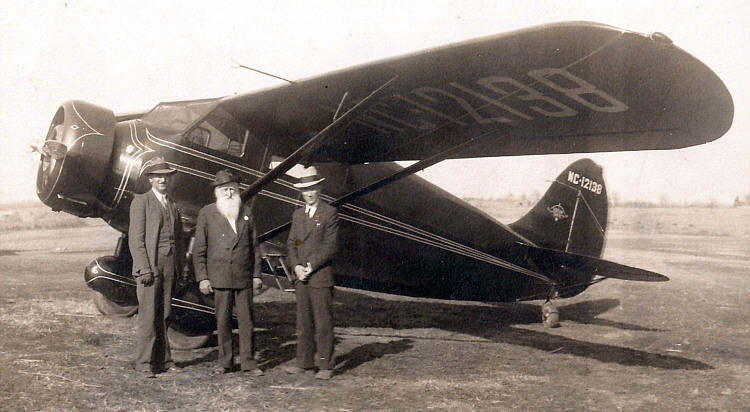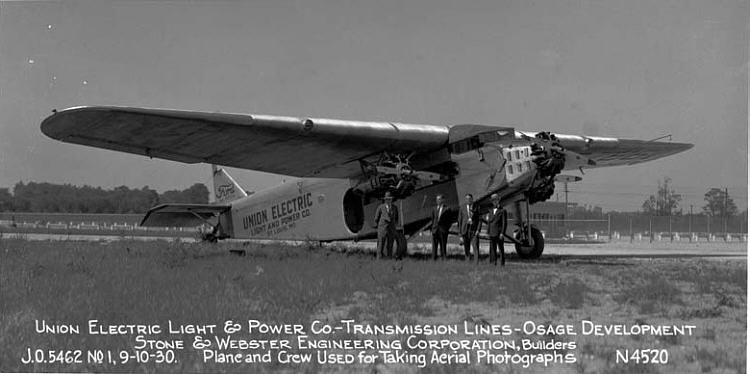
Aviation in Miller CountyEADS AVIATION
|
 |
| Squire John Ferguson, center, and Alf Eads, right, circa 1933 Stinson plane N/C 12138 |
It was an exciting day for the residents of Iberia. The merchants closed their doors and busy farmers deserted their plow handles to attend the official opening on that Saturday in late May which had been designated as "Lindbergh Day" across the country. It was an appropriate day for an airport dedication. One of the special events featured James G. Haizlip who had just won a trans-continental race. The cross-country flight lasted 10 hours and 19 minutes. James had flown 2500 miles from Los Angeles to New York just the year before and had been awarded the Bendix Trophy for his transcontinental flight. His wife, Mae Haizlip, who accompanied him to Iberia, was the winner of the women's speed record----she won this national race in 1932 at Cleveland, Ohio. Her speed was clocked at 265 miles per hour!

James G. Haizlip dedicated the new Eads Airport that day. He was the Assistant Manager of the Shell Petroleum Corporation's aviation department. Other performers during the day included a parachuting team called "The Three Black Cats". The three-man team consisted of Joe Switlik, William Hutchins, and Carl Lange from East St. Louis, Illinois. They flew into the airport in a Monocoach plane and used it in their stunt show. They parachuted from a height of 2200 feet, wore two parachutes each, and landed safely about one-quarter mile from the airport.
Other stunt performers were Walter Looney and Leonard Trowbridge of Springfield, flying an American Eagle, (a three-cylinder airplane). James Malone, accompanied by Ford Eads, son of Alf and Lou (Bond) Eads of Iberia, did some somersaults, rolls, tail spins, etc. in the Ead's Stinson aircraft. Other well-known aviators of the area were in attendance that day, including Harold Law and G. S. Salley in their Monocoupe from Jefferson City; W. E. Keith, Leslie Boos, and Louis Wilbers of LW Airways, in a Robin plane, also of Jefferson City; and B. M. Tuxhorn of Kansas City.
The following is a listing of other aviation events to happen in Miller County before history was made at the dedication of Eads Airport in Iberia in May 1933...........
In June 1930, Harry Tompkins and Leslie Burks, Eldon businessmen, purchased a Curtis-Robin monoplane, the first to be owned by residents of Miller County.
J. A. Eads of Iberia began to take flying lessons about 1931 and in December 1932, he bought a new Stinson, four-place cabin monoplane from B. M. Tuxhorn of Kansas City and in July 1933, obtained his private pilot's license. He could fly to St. Louis in 1 hour and 10 minutes while it took four hours by auto.
In November 1930, an airplane crashed in the north part of Iberia. Early on a Sunday morning, 13 Nov 1930, Arthur Perkins, living near the old New Light Church, was surprised when a plane dropped from the skies and came to rest in his barn lot, barely missing a huge elm tree, gouging its nose in the earth within 10 feet of his barn! Two young men, dressed in University of Missouri football uniforms, climbed out of the wreckage, uninjured but very bewildered. They asked where they were, thinking they were in the Westphalia (Osage County) area. The students had been in what they called "the Osage Dam country" and had lost their way of flight. (It was never explained why they were wearing football uniforms!!)

In 1930, Union Electric Power Company, owners of Bagnell Dam which was under construction at that time, bought the old Houston farm near the dam site to provide a landing field for airplanes which were used by the company's many officials and employees. Space available provided two runways; each 2000 feet long and 300 feet wide. In 1929 and 1930, the ace aviator for Union Electric was Earl G. Bahl who had once been the flying instructor for Colonel Charles A. Lindbergh. He piloted the company's tri-motor plane, which was named "Union Electric", and commuted daily between St. Louis and Bagnell Dam on a route that followed the electric transmission lines into the St. Louis area. Bahl had a barnstorming group of flyers in the early 1920s whom Lindbergh joined at Lincoln, Nebraska. Unfortunately, Earl Bahl was killed in an auto accident at St. Louis in October 1930 at the peak of his aviation career.
Miller County advanced to the more modern means of transportation in the early 1930s. Progress was made from the beginning.......from foot and horseback over old Indian trails; to ox-driven wagons; to stagecoaches, hacks, and buggies; the river carried flat-boats, keel boats, steamboats; in the early 1880s the railroad come to the county; in the early 1900s the horseless carriage/auto made an appearance and finally, in the late 1920s-early 30s, the airplane came to Miller County.
ELDON'S MODEL AIRPARK
In 1944, Eldon was going to make history by building the first airpark, a combination of a small plane airport and a city park. Aviation leaders wanted to prove that a conveniently located, landscaped airport with the capacity to handle non-commercial, personal planes was feasible, so they planned to have one built I Eldon to prove it. On October 16, 1944, Mayor Robert Reed and other civic leaders were approached by the government with the idea of building an airpark. The plan called for local financing and a record of all activities involving the airpark as an example of what airparks could be like. Civic leaders enthusiastically accepted and provided a site five blocks from the business district on the northeast edge of the city.
The next step was to get the permission of the people of Eldon for $25,000 in bonds to buy the site and construct the airpark. On February 13, 1945, Eldon voted in favor of the bond issue 682-77 thus taking the challenge to prove that small towns could finance airparks without the assistance of the state of federal governments.
On June 8 and 9, 1946, the Eldon Model Airpark was dedicated. The town threw huge celebration to mark the historic occasion. Large crowds were on hand for all events on Saturday's program and all were very much interested in the various planes which had been arriving for several days to the Airpark. Sunday's crowd was estimated at 8,000. The American Legion Post No. 229 presented a fine flag pole and flag as a new permanent installation in front of the new administration building.

|
P.O. Box 57 Tuscumbia, MO 65082 http://www.MillerCountyMuseum.org © 2007 - Miller County Historical Society millercountymuseum@att.net |

|